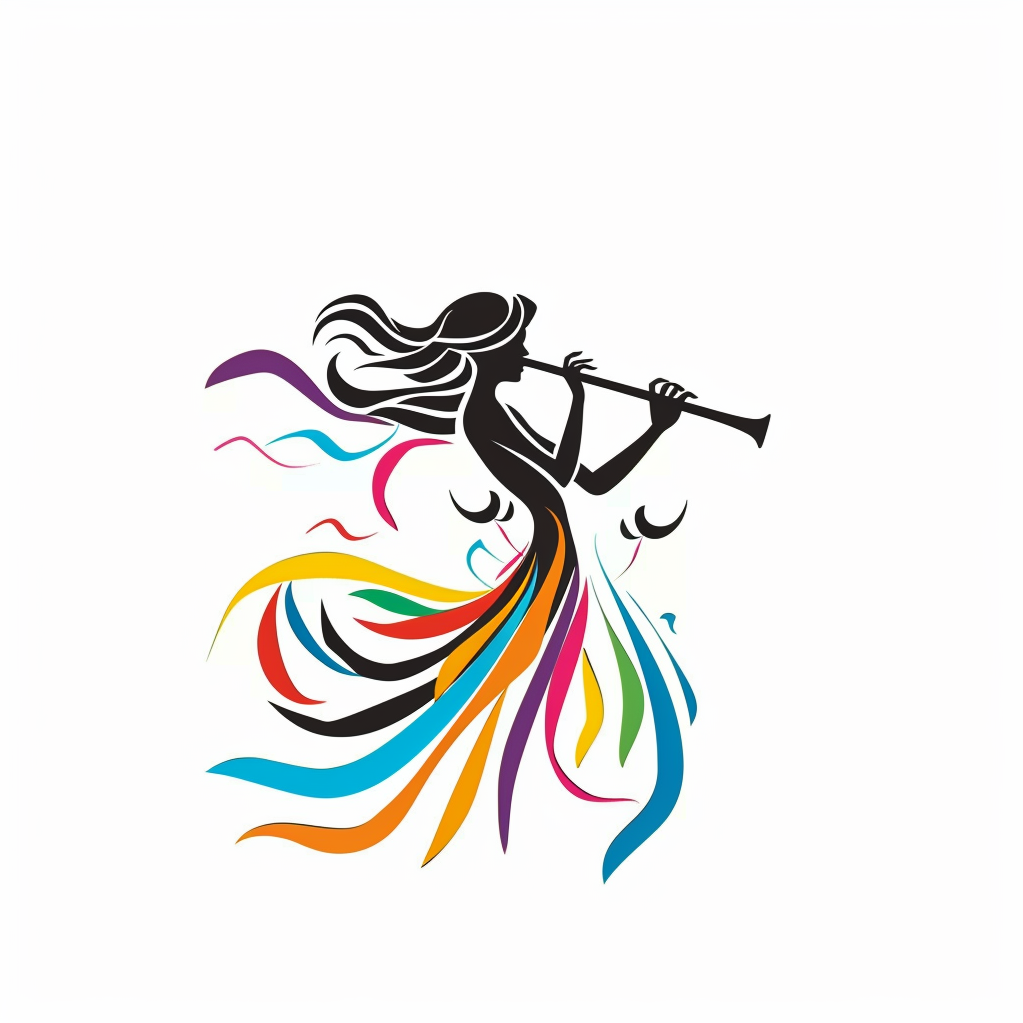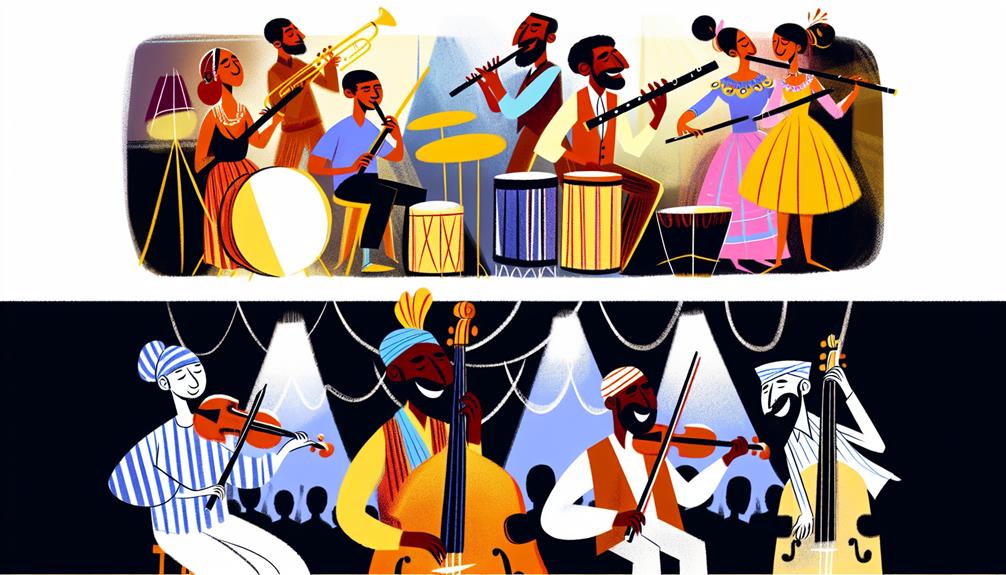The flute, a delicate and versatile instrument, weaves its melodic threads through various music genres, each time adapting to the unique demands of the musical landscape. From the hallowed halls of classical compositions to the sultry vibes of jazz clubs and the earthy resonance of folk melodies, the flute's presence is unmistakable. But what about its role in the more contemporary genres of music? How does this ancient instrument find its place and voice amidst the ever-evolving sounds of modern music? Let's explore how the flute continues to shape and enchant diverse musical genres, carving out its niche in the tapestry of musical expression.
Key Takeaways
- Flute adds a distinctive quality to classical music with its rich history and unique sound characteristics.
- In jazz, the flute's versatile melodic quality conveys complex melodies with a light tone, shaping mood in ensembles.
- The flute plays a poignant role in traditional folk music, adapting to various styles and cultural practices.
- In rock and pop, the flute's unique presence enhances soundscapes, though flute solos can be divisive among listeners.
- The flute's adaptability in fusion collaborations bridges cultural gaps, creating rich, textured music with diverse influences.
Flute in Classical Music
The flute, a versatile and sonorous woodwind instrument, has played a significant role in the development and performance of classical music for centuries. In classical music, the flute holds a distinguished position due to its rich history and unique sound characteristics. Flute technique in classical music is a crucial aspect that has evolved over time, shaping the way the instrument is played and perceived.
Historically, the flute has been a prominent instrument in orchestras and chamber ensembles, adding a delicate and expressive quality to musical compositions. During the Baroque period, composers like Johann Sebastian Bach and Antonio Vivaldi utilized the flute extensively in their works, showcasing its agility and lyrical capabilities. The development of flute technique during this era focused on improving articulation, tone production, and ornamentation, setting the foundation for future generations of flutists.
As classical music progressed into the Classical and Romantic periods, the flute continued to be a vital component in symphonies, concertos, and operas. Composers such as Wolfgang Amadeus Mozart and Ludwig van Beethoven explored the flute's dynamic range and expressive potential, pushing the boundaries of flute technique further. The evolution of the flute in classical music not only mirrored the changing styles and preferences of the time but also contributed to the instrument's versatility and adaptability in various musical contexts.
Flute in Jazz
Within the realm of jazz music, the flute emerges as a distinctive and versatile instrument, adding a unique melodic quality to ensembles and compositions. In jazz, the flute is valued for its ability to convey complex and intricate melodies with a light and airy tone that blends seamlessly with other instruments. Jazz flute players often showcase their virtuosity through improvisation techniques, where they spontaneously create melodies and embellishments, adding an element of surprise and creativity to performances.
The flute's agility and dynamic range make it well-suited for jazz fusion collaborations, where elements of different musical styles are combined to create innovative sounds. In these collaborations, flute players often explore new sonic possibilities by blending traditional jazz harmonies with elements of rock, funk, or world music. The flute's ability to navigate between different genres and styles makes it a sought-after instrument in jazz fusion projects, where musicians push the boundaries of conventional jazz music.
Moreover, in jazz ensembles, the flute is not only used as a melodic instrument but also as a textural element, adding depth and richness to the overall sound. Whether playing intricate solos or providing subtle harmonies, the flute plays a crucial role in shaping the mood and atmosphere of jazz compositions. Overall, the flute's versatility and expressive capabilities make it a valuable asset in the world of jazz music, enriching performances with its unique timbre and melodic possibilities.
Flute in Folk Music
An integral component of traditional folk music arrangements, the flute serves as a poignant and evocative instrument, deeply woven into the fabric of cultural storytelling and heritage. In folk music, the flute plays a crucial role in conveying the essence of traditional melodies, capturing the spirit of different cultures through its distinctive sound. Its versatility allows it to adapt to a wide range of folk music styles, from the lively reels of Irish folk music to the haunting ballads of Eastern European traditions.
The flute's presence in folk music dates back centuries, with its roots embedded in the cultural practices and oral traditions of communities around the world. Its ability to evoke a sense of nostalgia and connection to the past makes it a beloved instrument in folk music ensembles, where it often takes center stage in melodic lines and improvisational passages.
Beyond its musical contributions, the flute holds significant cultural significance in many folk music traditions. It is often associated with rites of passage, ceremonial events, and seasonal celebrations, where its melodies accompany dancers, singers, and storytellers in conveying the collective history and identity of a community.
Flute in Rock and Pop
Evolving from its traditional roots, the flute has found a unique and dynamic presence in the realms of rock and pop music genres. In these genres, the flute introduces a distinctive quality, adding a fresh layer to the soundscapes of popular music.
Flute solos in rock and pop music can be a point of contention among listeners. Some find them to be hyped, bringing a sense of novelty and intrigue to the songs, while others may perceive them as distracting, taking away from the overall energy of the track. The flute has the potential to stand out in a solo but must be executed thoughtfully to enhance rather than detract from the music.
When it comes to flute effects, there is a fine line between innovation and overdoing it. The flute's versatility allows for a range of effects to be employed, from distortion to delay, creating unique textures within a song. However, when these effects are overused or not integrated seamlessly into the music, they can become a gimmick rather than a musical enhancement.
Flute in World Music
The flute holds a significant role in a diverse array of traditional and contemporary musical expressions across cultures worldwide. In traditional ceremonies, the flute is often used as a sacred instrument, playing a vital role in various rituals and ceremonies. Its ethereal sound is believed to connect the physical and spiritual worlds, making it a common choice for traditional music in cultures such as Native American, Chinese, Indian, and African.
In modern fusion music, the flute has found a place in blending traditional sounds with contemporary styles, creating unique and innovative musical experiences. Artists and composers incorporate the flute into world music fusion, combining it with electronic beats, jazz harmonies, or rock rhythms. This blending of genres and styles allows the flute to transcend cultural boundaries, appealing to a global audience while still honoring its traditional roots.
To illustrate the diverse roles of the flute in world music, consider the following table:
| Traditional Ceremonies | Modern Fusion |
|---|---|
| Native American tribes | World music festivals |
| Chinese traditional music | Jazz fusion bands |
| Indian classical music | Electronic world music |
| African tribal rituals | Flute in pop music |
This table highlights the versatility of the flute, showcasing its ability to adapt and evolve within different musical contexts while maintaining its cultural significance.
Flute in Contemporary Genres
Within contemporary music genres, the flute serves as a versatile and dynamic instrument, contributing unique tonal qualities and enriching compositions across a wide spectrum of musical styles. In contemporary music, the flute is often integrated into fusion collaborations, blending traditional elements with modern sounds to create innovative and captivating music. Artists across genres such as jazz, pop, and electronic music have incorporated the flute into their work, adding a distinctive flair to their sound.
One notable aspect of the flute in contemporary genres is its role in experimental sounds. Musicians push the boundaries of traditional flute playing by exploring extended techniques, unconventional effects, and non-traditional musical structures. This experimentation leads to the creation of avant-garde compositions that challenge listeners' perceptions and expand the possibilities of flute music in modern contexts.
In fusion collaborations, the flute bridges cultural and stylistic gaps, bringing together diverse influences to create music that is rich in texture and depth. By blending elements from different musical traditions, artists can craft unique sonic landscapes that resonate with audiences worldwide. The flute's ability to adapt to a variety of musical settings makes it a valuable tool for artists seeking to explore new creative horizons and push the boundaries of contemporary music.
Frequently Asked Questions
Can the Flute Be Played in Multiple Genres by the Same Musician?
While the flute is traditionally associated with classical music, contemporary musicians are increasingly exploring its versatility in various genres. By engaging in flute fusion and cross-genre performances, musicians can showcase their musical diversity and experiment with the flute's potential in different musical landscapes.
This trend reflects a growing interest in pushing the boundaries of traditional instruments and incorporating them into diverse musical styles, enriching the overall music experience for both performers and audiences.
What Are Some Unconventional Ways the Flute Is Used in Music?
Exploring experimental flute techniques has led musicians to innovate by fusing the flute with electronic music, creating unique soundscapes.
From using the flute as a percussion instrument by beatboxing through it to incorporating pedals for looping effects, these unconventional methods showcase the versatility of this classical instrument in modern music.
Such experimentation pushes boundaries and demonstrates the flute's adaptability across genres, making it a dynamic tool for musical expression.
Are There Specific Types of Flutes Used in Different Genres?
Flute variations play a crucial role in different music genres due to regional preferences and historical significance.
Modern adaptations of the flute in various genres often blend traditional techniques with contemporary styles, showcasing the instrument's versatility and adaptability.
Understanding the specific types of flutes used in different genres provides insights into the evolution of music and the cultural influences shaping musical expressions worldwide.
How Does the Flute Contribute to the Overall Sound in Various Genres?
The flute, through its versatile techniques and ability to blend styles, contributes significantly to the overall sound in various genres.
Whether through intricate flute solos that captivate listeners or by seamlessly fusing genres together, the flute adds depth and richness to music.
Its unique timbre and agility allow it to play a vital role in shaping the sonic landscape of diverse musical compositions, making it a cherished instrument across different genres.
Are There Any Famous Flute Players Known for Their Versatility Across Genres?
When considering flute legends who excel in crossover styles, certain genre-hopping flutists stand out for their iconic performances that traverse various musical genres.
These individuals have showcased their versatility by seamlessly transitioning between different styles, leaving a lasting impact on the music world.
Their ability to masterfully adapt to diverse genres while maintaining their unique flute-playing style has solidified their reputation as trailblazers in the realm of music.
Conclusion
In analyzing the role of the flute in various music genres, it is evident that its versatility and unique sonic qualities make it a valuable instrument across different musical landscapes.
One interesting statistic to highlight is that the flute is one of the oldest musical instruments, with evidence of its existence dating back to over 35,000 years ago.
This longevity and enduring popularity in diverse genres underscore the flute's enduring appeal and significance in the world of music.

